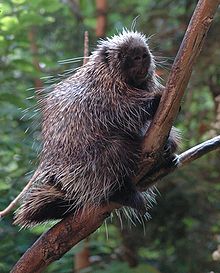North American porcupine
| North American porcupine Temporal range: - Recent |
|
|---|---|
 |
|
| Scientific classification | |
| Kingdom: | Animalia |
| Phylum: | Chordata |
| Class: | Mammalia |
| Order: | Rodentia |
| Family: | Erethizontidae |
| Subfamily: | Erethizontinae |
| Genus: |
Erethizon F. Cuvier, 1823 |
| Species: | E. dorsatum |
| Binomial name | |
|
Erethizon dorsatum (Linnaeus, 1758) |
|
| Subspecies | |
|
|
| Synonyms | |
|
Erethizon dorsata |
|
Erethizon dorsata
Erethizon dorsatus
The North American porcupine (Erethizon dorsatum), also known as the Canadian porcupine or common porcupine, is a large rodent in the New World porcupine family. The beaver is the only rodent in North America that is larger than the North American porcupine. The porcupine is a caviomorph rodent whose ancestors rafted across the Atlantic from Africa to Brazil over 30 million years ago, and then migrated to North America during the Great American Interchange after the Isthmus of Panama rose 3 million years ago.
The word "porcupine" comes from the middle or old French word porcespin, which means quill pig. Its roots derive from the Latin words porcus or pig and spina meaning thorns. Other colloquial names for the animal include quill pig. It is also referred to as the Canadian porcupine or common porcupine. The porcupine's scientific name, Erethizon dorsatum, can be loosely translated as "the animal with the irritating back". Several Native American names exist, such as the Lakota name pahin meaning quill and the Chipewyan name ts'l.
The North American porcupine migrated from South America, where all New World porcupines or hystricomorphs evolved. Erethizon appeared in North America shortly after the two continents joined together in the later Tertiary period. Other hystricomorphs also migrated, but Erethizon was the only one to survive north of Mexico. No known fossils are attributed to hystricomorphs prior to the late Tertiary period. Some fossils, such as species from the family Paramyidae, show resemblance to the porcupine, but they are so primitive and generalized that they could be ancestors to all later rodents.
South American hystricomorphs first appeared in the Lower Oligocene period. They are thought to have migrated from Africa, ancestors of the Old World porcupines or Hystricidae or they originated based on a migration of the North American Paramyidae.
...
Wikipedia

